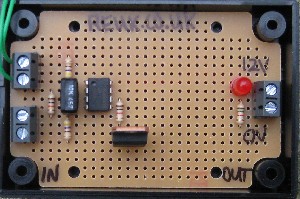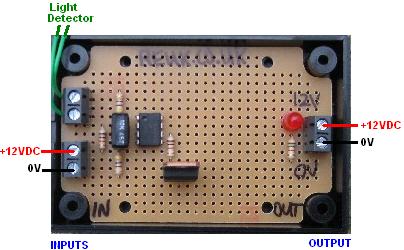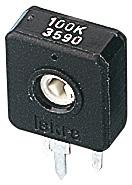
Additional Information
As described in our article LM741 Light/Dark Sensor Circuit, this circuit is designed to be used to control low current 12 Volt lighting and devices according to the level of ambient natural light.
This circuit is particularly suited for use with low voltage LED spotlight bulb lighting, automatically turning on the bulbs in the darkness of nighttime and turning them off again during the daytime. This circuit has been tested with output current loads of up to 3 Amps* (equivalent to 20+ LED spotlights)
* If you need to control an output current in excess of 3 Amps we recommend you use our new Light/Dark Sensor Circuit (Relay) which can control loads of of up to 10-12 Amps.
NEW PRODUCT Jan 2012 – Click here to view details of our new improved REUK Super LDR Dusk Dawn Relay Controller which offers five user programmable modes of operation – on when dark, on when light, on from dusk until dawn, on for X hours after dusk, and off for X hours after dusk and then on until dawn.
Powering the Controller
This is a 12VDC powered device, and so should be powered either by a solar charged or otherwise 12V battery or with one of our mains plug-in 12VDC power supplies if you are using less than around 4 Watts of lighting.
Connecting the Circuit
This circuit is very simple to connect into your 12 Volt lighting system. See the diagram below:

The light dependent resistor (LDR) should be positioned so that it is not illuminated by any lights under the circuit’s controls. Instead the LDR must be pointed in the direction of the natural light source to be measured.
With everything connected up as shown above, the sensitivity of the circuit can then be configured. The component labelled “Sensitivity Adjustment” is an adjustable resistor/potentiometer similar to the one pictured below:

Using a very small flat or phillips head screwdriver, or the point of a suitably sharp knife, and approaching the variable resistor from the output side (the right hand side of the labelled connection diagram), the sensitivity to light of the circuit can be adjusted in the following manner.
Turn clockwise to turn on the output in brighter conditions – for example, turning lights on at the very start of dusk and turning them off again at only at the end of dawn.
Turn anti-clockwise to turn on the output only in duller conditions – for example, turning on lights only when it is very dark.
Very small adjustments can be made to set the turn on/off point to your exact switch on point requirements (ranging from total darkness, to very dazzlingly bright). The LED indicator will light when output power is available (i.e. it is dark enough), and will turn off when output power is not available (i.e. when it is too bright).
NEW This circuit has now been improved thanks to feedback from our customers. Now the LDR is provided fitted to approx 300mm leads which are connected to screw-in terminals on the circuit board. This makes fitting the LDR in the optimal position far easier and makes this circuit suitable for a wider range of applications.
Quick Set Up Instructions
The easiest way to set everything up is simply to wait until evening and your chosen level of darkness: Adjust the variable resistor very slowly until the LED indicator is just coming on making sure that your hand/body is not shadowing the LDR. Your circuit will then be set up to turn on the lights and/or devices it controls automatically whenever it is that dark or darker.